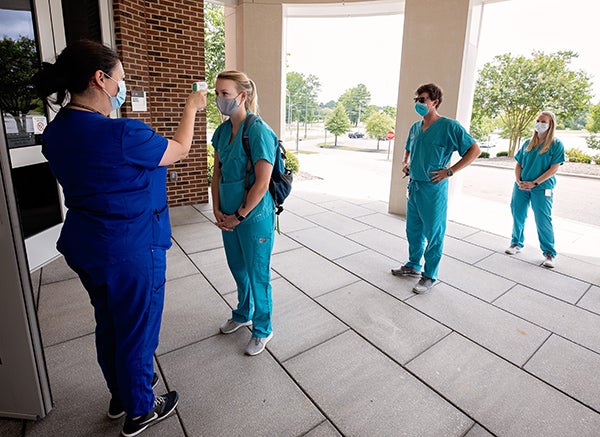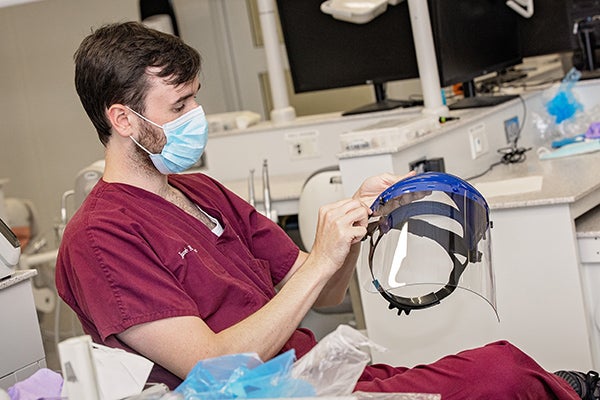Dental students return to patient care across North Carolina
After a hiatus from patient care that lasted more than three months due to the COVID-19 pandemic, ECU School of Dental Medicine students have returned to campus clinics and the school’s community service learning centers (CSLCs) across the state.
Safely re-incorporating students into patient care across the state involved carefully crafted layers of planning among school and university leadership and input from state and national health experts and organizations.

Nicole Alley, dental clinic administrator for the ECU School of Dental Medicine, screens dental student Omar Glover at Ross Hall before he begins providing clinical care to patients. Fourth-year dental students have returned to Ross Hall clinics and community service learning centers across the state. (Photos by Cliff Hollis)
The school’s response effort has been organized through the SoDM COVID-19 Response Team, led by Vice Dean Dr. Margaret Wilson. The team was created in March as the pandemic evolved and school leaders made operational decisions based on input from the SoDM community and many overlapping, strategically chosen units.
“The COVID-19 Response Team has worked diligently to make decisions through a combination of knowledge, expert guidelines, scientific evidence and considerations for the safety of the SoDM community,” Wilson said. “The decision to bring our students back to campus and clinics for direct patient care was made with confidence in our faculty, staff, students and residents, and represents a positive step forward during an extraordinary and uncertain time.”
Since the pandemic crisis began impacting patient care in the dental school’s clinics on campus and across the state, the school’s faculty and residents continued treating emergency patients to alleviate strain on hospitals and emergency departments.
There were both immediate and gradual updates in safety protocol, including additional personal protective equipment (PPE) for providers such as face shields, and clinic equipment updates like additional sneeze guards in clinics and patient-traffic areas. Other safeguards evolved, based on input from those working with emergency patients throughout the pandemic.
A Clinical Operations Team also led much of the school’s efforts to assess the safety and process of re-incorporating students to patient care environments. The school organized into sub-units that assessed specific functional areas including clinic, educational operations, administrative functions, IT capabilities, research and student, staff and faculty needs.
Information from the American Dental Association, American Dental Education Association, the CDC, OSHA, ECU and other sources were utilized to develop re-entry plans for dental students. Plans were vetted through the sub-units, routed to the dental school dean, the vice chancellor for Health Sciences and finally the ECU’s Main Campus Experiential Learning Committee.
One of the most important steps of the process begins right at the door—where anyone who enters a campus facility or CSLC is screened for temperature and asked a series of health questions to determine any presence of illness or symptoms. The eight CSLCs used the same screening protocol, tailored to their facility-specific design.
That screening process has been vital to preserving safety inside buildings and to acclimating students with a more intricate routine upon arrival and heightened awareness in patient care areas.
“The key to keeping us all safe is having a consistent screening process for literally everyone who comes in,” said Kimberly Werth, interim associate dean of student affairs for the dental school. “It has helped the students appreciate what they need to do as growing professionals.”
‘How can I help?’
Robert Pinner, a fourth-year dental student (D4) on rotation at the school’s CSLC–Elizabeth City, said returning to clinic renewed his sense of purpose in health care.
“It was refreshing to get back to work,” Pinner said. “I can focus on dentistry and my patients—that’s what I want to do. I’ve had some patients that needed immediate treatment; being able to get them out of pain makes me feel like an integral part of the health-care field.”

School of Dental Medicine Dental Clinic Administrator Nicole Alley takes student Emory Byrd’s temperature as she screens students outside Ross Hall. Fourth-year dental students have returned to providing patient care in clinics and community service learning centers across the state.
D4 students are treating patients with both emergency and routine cases. D3 students have returned to Ross Hall to complete curriculum benchmarks in preparation for direct patient care in the coming weeks. The Class of 2023 continues with remote instruction, and the school plans to welcome the Class of 2024 on Aug.10.
With those plans in motion, students are eager to move forward and bring smiles back to patients’ faces.
“I’m excited to get back to work, and I’m excited to have the support of my school,” Pinner said. “Situations like this COVID-19 pandemic require guts to navigate. It makes me proud to see our administration go to bat for us. They’ve worked immeasurably hard to get us back in the clinic so soon, and they’ve allowed us to get back to serving the people of North Carolina.”
Caitlin Melvin, D4, is adjusting not only to new regulations in providing care—but also to a new community. She began a rotation at CSLC–Lillington at the end of June and has spent time navigating new PPE, learning the layout of a new setting and trying to recover her sense of connection with patients. While the added PPE creates barriers between patient and provider, they also help Melvin recall why she chose her field.
“That connection is what drew me to dentistry,” she said “There is just something about being able to sit down face to face with my patients and talk with them and really get to know them. The whole atmosphere has changed since COVID. I feel I am less able to focus on getting to know them, and that in itself places a mental barrier between us.”
That less tangible obstacle is one Melvin is determined to overcome, especially with a sense of renewed energy in the normalcy of once again treating patients.

Third-year dental student Jacob R. House assembles his face shield during a class on proper PPE techniques. ECU School of Dental Medicine D3 students have returned to Ross Hall to complete curriculum benchmarks in preparation for direct patient care in the coming weeks.
“I was so excited to return to clinic,” she said. “Seeing patients brings me so much joy. I have several patients that are getting quite a bit of work done, and I have been checking on them periodically throughout the pandemic. Being able to finally get them back in the chair has been awesome.”
Having more patients back in those chairs means considerations that come with dental work. Much of the upgraded equipment focuses on containing aerosols—fine mists or particles that result from some dental procedures and are the greatest airborne infection threat in dentistry.
“We have a lot of guidelines in place to make sure that aerosol is contained and rooms are disinfected properly,” Melvin said, adding that upholding new safety guidelines has been a team effort.
That teamwork derives from school faculty, staff and leadership—who have guided the School of Dental Medicine family to adapt to multiple challenges along the way. The dental school’s Office of Student Affairs has also offered resources to guide students as they return, Werth said, and students themselves have adapted to extraordinary circumstances as changes to classroom, curriculum and clinic have transformed their education as they once knew it.
“Students have consistently risen to the challenge and shown such patience throughout,” she said. “They’ve said to us, ‘What can I do to make this transition smooth? How can I help make it happen?’”